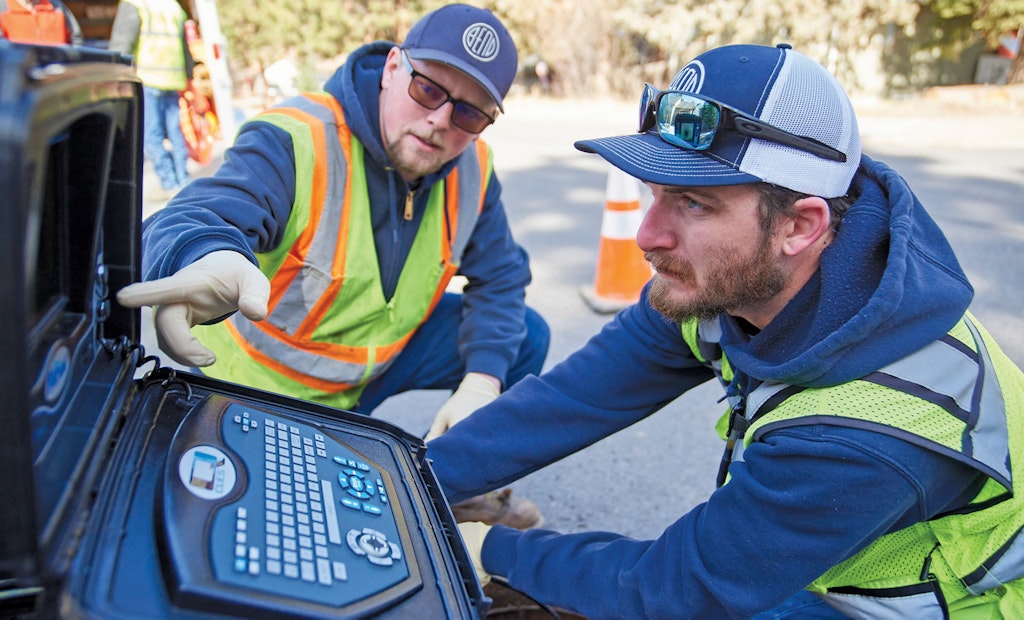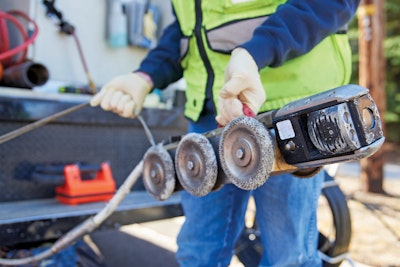
Bend Collections Utility workers Justin Young (left) and Joe Johnson maneuver and monitor a Cues MPlus camera system to check a repair they just completed on a sewer line.
Interested in Infrastructure?
Get Infrastructure articles, news and videos right in your inbox! Sign up now.
Infrastructure + Get AlertsOn the surface, the city of Bend, Oregon, appears just like any midsize growing city, but unusual patterns of growth in tough terrain have created a unique wastewater collections system with an enormous number of lift stations.
Bend is meeting the challenge, however, and it’s mission to reduce its carbon footprint and improve the collections system overall is being aided by progressive ideas, innovations and many new technologies to create a highly sustainable utility of the future for this high desert metropolis.
Built on bedrock
Incorporated in 1905, the city of Bend covers an area of approximately 33 square miles and is home to more than 94,000 residents. The city has seen tremendous growth, from a small city of 35,000 in 1999 to just under 100,000 in 2019, and new development continues.
The Bend Utility Department is responsible for maintenance of the region’s sewer and stormwater conveyance systems, as well as treatment. Its sanitary collections system includes 474 miles of pipe and 74 lift stations. In addition to those structures there are 330 residential lift stations that the city is also responsible for maintaining.
“There has been a big effort here in the last few years to upgrade our interceptor lines so we can start moving away from the operations of all these lift stations and shift to more of a gravity or traditional system,” explains Troy Beck, utility field operations manager for the city of Bend Utility Department. “We have challenges to overcome because our terrain is solid rock, so costs to trench gravity mains and interceptor lines can become prohibitive.”
The complexity of the lift station-heavy system came about from development that didn’t take place in a uniform pattern as the city was expanding. As developers came in and put in new subdivisions and business parks, the utility had to figure out a way to get wastewater conveyed from point A to point B. This created a patchwork of small stand-alone systems. As more developments popped up, code didn’t allow the utility to mandate upgrades or improve what was currently in place, so each new development was allowed to create another stand-alone system or drainage basin.
Over time, opportunities existed to improve functionality and tie some of the stand-alone systems together. Varying pressures and hydraulic limitations did not allow all the systems to be connected, so Bend still has a sizeable network of individual drainage basin areas.
Maintenance and improvement
Bend performs most of its routine CCTV inspection, cleaning and maintenance tasks with its in-house crew and a fleet of equipment that includes two CUES CCTV inspection vehicles, four Vactor jet/vac trucks, three service spot crane trucks and eight normal work trucks. Crews also perform some CIPP short-liner point repairs, but the city contracts out the larger projects such as corrosion prevention and manhole-to-manhole CIPP rehabilitation to local specialty contractors. The utility department’s CCTV operators are all PACP-certified, and data is captured using GraniteNet data collection software (CUES), which works in tandem with the department’s Esri ArcGIS system and asset management software. These tools have allowed the utility to build a robust preventive maintenance program, with a goal of inspecting and cleaning the entire system on a five-year cycle.
In order to reduce future maintenance burdens, new development codes do not allow the addition of local lift stations for new subdivisions. Only gravity sanitary systems are permitted. Bend is currently revamping and rebuilding some of its existing lift stations that have been identified as long-term essential structures for the system, and several new interceptor lines have also been added to the system to replace lift stations that were taken offline.
These initiatives are all part of the Collection System Enhancement Program that was identified through Bend’s Engineering Department.
“We developed a collections system master plan to identify opportunities that would allow us to eliminate a number of lift stations and convert them to gravity-feed,” Beck says. “By the same token, a good number of lift stations cannot be removed or converted for various reasons, so a condition assessment on those has been performed by our crews and we are now mapping out what structures will be upgraded.”
Upgrades for the lift stations will include the installation of new pumps, new drives and in some cases completely new wet well components including controls, transducers and floats. Many of the lift stations will be outfitted with pumps with SmartRun drives (Flygt - a Xylem Brand). The advantages of these pumps for Bend are their nonclog properties and ability to detect resistance from a blockage. The pumps will go into a reverse spinning mode, going backward and forward up to 20 or 30 times until it can clear the blockage.
“It can clear these blockages on its own in about 90% of the cases, which has been really helpful so that we don’t have to deploy emergency staff as often,” says Orrin Libolt, collections system supervisor. “This has reduced emergency-response labor costs. In the rare case when it can’t self-clear, it will alert us so we respond appropriately.”
Bend tries to repurpose as much as possible when dealing with removal, maintenance or upgrading of the lift station structures. “We are working to ensure they are sized appropriately to fit the daily flow rates entering the stations,” Beck says. “We examine many factors or approaches, like complete removal, salvage and also the opportunity to introduce space for the implementation of odor control methods. These factors are weighed in for determining solutions with the best possible return on investment.”
Replacement of access frames and covers in structures experiencing corrosion is also part of the Collection System Enhancement Program. Bend opted to begin utilizing EJ composite access frames and covers, complete with Titus TwistLift Security Locks. The composite lids are easier for crews to lift and handle, and the TwistLift locks have helped standardize their locking mechanism. Over the years, Bend had adopted several locking mechanisms that required crews to carry multiple keys. They are now working to reduce this and phase everything over to this single mechanism.
Reducing the footprint
As part of Bend’s climate action plan and mission to reduce its carbon footprint, the City Council tasked all its departments to investigate and implement methods to improve energy efficiency and reduce waste when and where it makes sense.
Bend’s 330 residential lift stations are comprised of a mix of standard pump and vacuum-style units. The 82 vacuum units have some odor emission, but this can be handled effectively with a media filter on the unit’s exhaust pipe, and for the most part, these structures are airtight. The standard stations have always demanded more attention for odor mitigation.
With the goal of reducing the carbon footprint, Libolt and Beck started coming up with ideas related to the standard lift station odor control measures, which were handled by chemicals. These chemicals were sourced and trucked in from Texas. From there, it was transferred to smaller tanker trucks that were dispatched to sites across town for the servicing of the various lift stations.
“We began looking at alternatives to controlling the odor onsite without relying on trucked-in chemicals, and eliminating the tanker vehicles from our fleet as our way to reduce the footprint,” Beck says. “Our biggest challenge was making sure that we handled this in a responsible way and that whatever we shifted to was going to not only be an improvement to what was currently in use, but also fit with our climate action plan goals.”
Bend was given an opportunity to test a new odor mitigation solution from Titus on a two-year pilot program. Titus Twister aerators with an ozone generator have been installed in several lift stations and have produced favorable results with both odor and FOG. In fact, instead of getting the typical complaints from residents near the stations, Bend is getting thank-you letters from residents living near stations with the Titus Twister units, citing that this has created a wonderful and positive change to their neighborhoods.
“As you know, with infrastructure and new technology, it’s all about longevity; but from what we have experienced to date, we’re happy and hopeful this could be a sustainable solution for our lift station odor mitigation,” Beck says. Bend is currently working on the design of another lift station upgrade and has specifically made space for a Titus Twister unit.
The utility department has also made strides in eliminating redundant vehicles and high energy and labor practices from its routine preventive maintenance programs. One highly effective approach has been the use of rapid assessment tools instead of deploying a combination truck to a basin and cleaning it — regardless of whether it’s needed — just because its turn comes up on the maintenance schedule.
The SL-RAT from InfoSense is a rapid acoustic assessment tool that is helping Bend maintain and assess the health of its system more efficiently both in terms of labor, energy and equipment. “Typically, our system is in good shape in newer areas where it is predominantly PVC and doesn’t need cleaning,” Libolt explains. “This assessment tool helps us focus our line-cleaning and root-cutting efforts where we need it, such as the older parts of town. It is helping us get through our system better, faster and eliminating SSOs.”
Because of all the lift stations, hydrogen sulfide problems and erosion of substrate can be severe in some areas. By cleaning only when necessary, the invasive and sometimes destructive effects of high-power jetting can be reduced, thus helping to extend asset life.
Considering all options
Due to its rapid population and development, Bend has experienced growing pains on multiple levels, but through it all, they have stayed in front of the wave by adopting an attitude of openness toward changing the way they do business.
“We’ve utilized some new technologies and refined how we go about our daily operation and energy consumption. Even with the rapid amount of growth, we haven’t needed to increase staff, yet our SSOs are down and our PM tasks are on target,” Beck shares proudly. “We want to leave it better than we found it. So when we make decisions and evaluate products, we ask ourselves: What advantage is to be gained for our crew, our utility and the ratepayer? Because the decisions we make today will impact the people who will be doing our jobs in the future. If we feel it will make sense to someone 50 years from now, then we know we’re doing the right thing for our community.”









